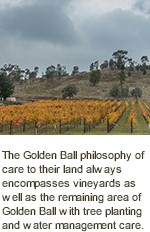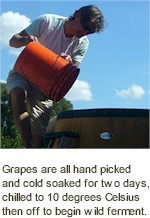


The Golden Ball estate vineyards and wineworks are located in northeast Victoria within the Geographical Wine Indication of Beechworth. Presently, now 53 acres, the property purchased in 1996 by James McLaurin, consisting of the 1996 Original Vineyard and in 2005 the Lineage Vineyard. A monopole property, all wines are entirely grown, vinified and bottled on the property. No insecticides, hand pruned and shoot thinning The vineyard is drip irrigated just prior to verasion, with a dry spring however, this may commence slightly earlier. Watering is very limited to keep small berry size carrying most of the fruit through to slow vigour. Verasion sees some definite bunch thinning to balance ripening ability.

The Golden Ball philosophy of care to their land encompasses vineyards as well as the remaining area of Golden Ball with tree planting and water care. Low yields result in intensely flavoured wines being taken up by Australia’s greatest 1, 2 and 3 hatted restaurants and private clients through their mailing list. The Golden Ball wines are reviewed by wine critics of esteem both nationally and internationally. The vineyards drip irrigation water is sourced from estate dams which are fed by winter and spring run off. No bore, well, creek or river pumping of this precious resource. Winery water is caught on the winery and barrel room roofs. Wines produced are là-bas Chardonnay, bona-fide Savagnin CHERISH Rose, SAXON Shiraz and GALLICE Cabernet Sauvignon, Merlot, Malbec.
The original Vineyard 4.5 acres (2 hectares) 1996 Chardonnay (grafted in 2014 from Shiraz) Cabernet Sauvignon, Merlot, Malbec, first vintage 2002, rows run Northeast/Southwest, slight Northwest facing, gentle slope, planted on deep decomposed granite and light clay, 800 mm cordon height, loose VSP canopy (vertical shoot position)
The Lineage Vineyard 3.5 acres (1.5 hectares) Planted 2005, Close planted unicordon, Shiraz, Savagnin, Cabernet Sauvignon (not producing) Petit Verdot (not producing) Sagrantino (not producing) 800 mm cordon. North/Northwest facing, granite buckshot site. Rows run up steep hill facing North/Northwest, loose VSP canopy (vertical shoot position)

Grapes are all hand picked and cold soaked for two days, chilled to 10 degrees Celsius then off to begin wild ferment. Batches are pressed, settled overnight then put to barrel in 1/3 new French oak, the rest two to three years old. Initial ferments and malolactic are brought about from the yeasts endemic to the vineyards. A spell of 17-18 months oak ageing contact, withstanding rackings and a minimum of five months bottle age pre release. In September 2005 Golden Ball began planting three acres of a six acre site to Shiraz, on a north/north west facing slope. In 2009, half an acre of Savagnin, a white French variety. Spring 2010, some Cabernet Sauvignon, Petit Verdot and Sagrantino. The new varieties on this slope should do very well and suit the micro-climate. There are no CCA (copper-chromium-arsenate) pine posts used, only railway iron and red box/Murray pine plantation timber. This vineyard will be organically principled to begin, and then the biodynamic ethos introduced.
Since 2010 they have been producing their own electricity, through a five kW solar grid feed system. In December 2013 they grafted some original vines to two excellent Burgundian Chardonnay clones. The grafts have annealed very well. The excellent cool site has produced our first Golden Ball Chardonnay for the 2015 vintage. The priorities are always about quality of fruit, excellence of wine and sanctity of the environment. Everything at Golden Ball is done to make the finest Beechworth wine, while preserving the natural health and balance of the land.